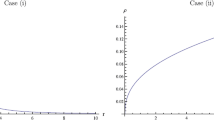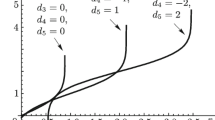Abstract
We derive conformally flat cylindrically symmetric solutions for spacetimes with a cosmological constant and investigate the matching problem of these solutions with the exterior Linet–Tian spacetime.
Access provided by Autonomous University of Puebla. Download conference paper PDF
Similar content being viewed by others
Keywords
These keywords were added by machine and not by the authors. This process is experimental and the keywords may be updated as the learning algorithm improves.
1 Introduction
In General Relativity, cylindrical solutions have been used to study various fields such as cosmic strings, exact models of rotation matched to different sources and models for extragalactic jets and gravitational radiation. The generalization of the Levi–Civita spacetime to include a nonzero cosmological constant Λ was obtained by Linet [1] and Tian [2]. It was shown by da Silva et al. [3] and Griffiths and Podolsky [4] that it changes the spacetime properties dramatically. The Linet–Tian (LT) solution has also been used to describe cosmic strings and, in [5], static cylindrical shell sources have been found for the LT spacetime with negative cosmological constant. Considering the extensive interest in cylindrically symmetric solutions it is worthwhile to analyse some further properties of LT spacetimes.
In this note, we summarize the results of [6], which show that it is possible to match static cylindrically symmetric conformally flat solutions of the Einstein field equations with a cosmological constant Λ with the exterior Linet–Tian spacetime if Λ > 0.
2 Static Cylindrically Symmetric Anisotropic Sources with Λ ≠ 0
Consider static cylindrically symmetric anisotropic matter bounded by a cylindrical surface S and with energy momentum tensor given by
where μ is the energy density, P r , P z and P ϕ are the principal stresses and V a , S a and K a satisfy \({V }^{a}V _{a} = -1,\) \({S}^{a}S_{a} = {K}^{a}K_{a} = 1,\) \({V }^{a}S_{a} = {V }^{a}K_{a} = {S}^{a}K_{a} = 0.\) For the interior to S the static cylindrically symmetric metric can be written as
where A, B and C are functions of r. The non-zero components of the Einstein Field Equations \(G_{\mathit{ab}} = T_{\mathit{ab}} -\varLambda g_{ab} \equiv \bar{ T}_{\mathit{ab}}\) are
where the primes stand for differentiation with respect to r. The regularity conditions at the axis are \(A^{\prime}(0) = B^{\prime}(0) = {C}^{{\prime\prime}}(0) = C(0) = 0,\) \(B(0) = C^{\prime}(0) = 1\) (see [7]).
3 Conformally Flat Solutions
For a conformally flat interior spacetime, all Weyl tensor components vanish and one obtains the following non-linear second order ordinary differential equations for h and S (see [8]):
where \(S = \frac{A^{\prime}} {A} -\frac{B^{\prime}} {B},\;\;h = \frac{C} {B}.\)
Integrating these equations and using the regularity conditions gives \(h =\ a_{1}\sinh (a_{2}r)\) and \(A = a_{3}\cosh (a_{2}r)B;\) where a 1, a 2 and a 3 are non-zero integration constants,.
Considering the case \(\bar{P}_{r} =\bar{ P}_{\phi }\), it follows that the metric functions A, B and C in (1) are (see [6])
where a 2 and a 4 ≠ 0 are constants. The density and pressures are given by
4 Matching to an Exterior
Consider the exterior Linet–Tian spacetime \(({M}^{+},{g}^{+})\) whose metric is given by
where \(\varSigma = 1 - 2\sigma + {4\sigma }^{2},\) and for Λ > 0, \(Q(\rho ) = \frac{1} {\sqrt{3\varLambda }}\sin (2R),\) \(P(\rho ) = \frac{2} {\sqrt{3\varLambda }}\tan R,\) with \(R = \frac{\sqrt{3\varLambda }} {2} \rho\). Matching this metric to the interior solution presented in the previous section, one obtains from the equality of the first fundamental forms:
and from the equality of the second fundamental forms:
where \(\stackrel{S}{=}\) denotes equality on the matching hypersurface only. From these equations one obtains
and
The inequality \(0 {\leq \sin }^{2}R_{S} \leq 1\) in (8) and the positivity of the right hand side of (10), for any 0 < σ < 1∕4, are satisfied if \(1/2 \leq a_{4} \leq 1\).
The parameter a 2 is fixed by (10) whilst ρ S and r S are determined from (8) and (9); equations (2)–(4) fix the exterior parameters a, b and c. Thus we conclude that the matching is possible for any 1∕2 ≤ a 4 ≤ 1, 0 < σ < 1∕4 and Λ > 0. See [6] for more details.
References
B. Linet, J. Math. Phys., 27, 1817, (1986).
Q. Tian, Phys. Rev. D, 33, 3549, (1986).
M.F.A. da Silva, A. Wang, F.M. Paiva, N.O. Santos, Phys. Rev. D, 61, 044003, (2000).
J. Griffiths, J. Podolský, Phys. Rev. D, 81, 064015, (2010).
M. \(\check{Z}\) ofka, J. Bi\(\check{c}\)ák, Class. Quant. Grav., 25, 015011 (2008).
I. Brito, M.F.A. da Silva, F.C. Mena, N.O. Santos, Gen. Rel. Grav., 45, 519, (2013).
T. Philbin, Class. Quant. Grav., 13, 1217, (1997).
L. Herrera, G. Le Denmat, G. Marcilhacy, N.O. Santos, Int. Journ. Mod. Phys. D, 14, 657, (2005).
Acknowledgements
IB and FM thank CMAT, Univ. Minho, for support through the FEDER Funds COMPETE and FCT Project Est-C/MAT/UI0013/2011. FM is supported by FCT projects PTDC/MAT/108921/2008 and CERN/FP/116377/2010.
Author information
Authors and Affiliations
Corresponding author
Editor information
Editors and Affiliations
Rights and permissions
Copyright information
© 2014 Springer-Verlag Berlin Heidelberg
About this paper
Cite this paper
Brito, I., de Fátima A. da Silva, M., Mena, F.C., Santos, N.O. (2014). Matching the Linet–Tian Spacetime with Conformally Flat Cylindrically Symmetric Sources. In: García-Parrado, A., Mena, F., Moura, F., Vaz, E. (eds) Progress in Mathematical Relativity, Gravitation and Cosmology. Springer Proceedings in Mathematics & Statistics, vol 60. Springer, Berlin, Heidelberg. https://doi.org/10.1007/978-3-642-40157-2_72
Download citation
DOI: https://doi.org/10.1007/978-3-642-40157-2_72
Published:
Publisher Name: Springer, Berlin, Heidelberg
Print ISBN: 978-3-642-40156-5
Online ISBN: 978-3-642-40157-2
eBook Packages: Mathematics and StatisticsMathematics and Statistics (R0)




